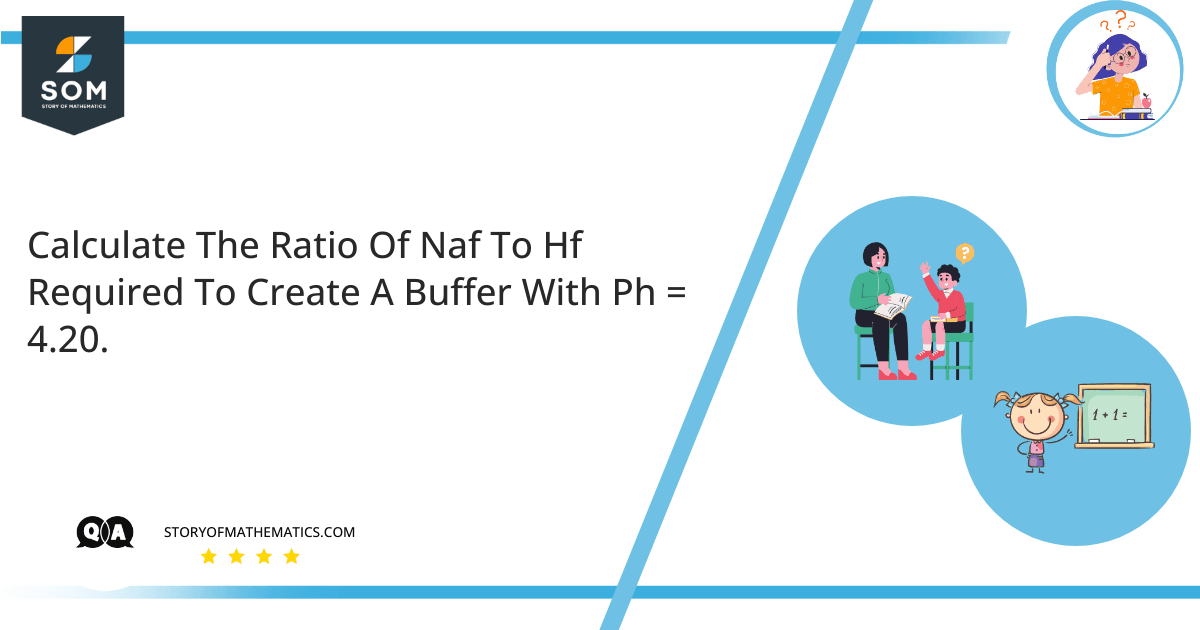
This question aims to find the ratio of Sodium Fluoride (NaF) to Hydrogen Fluoride (HF) that is used to create a buffer having pH 4.20 .
The pH of a solution determines whether a solution is basic or acidic. pH is measured by a pH scale which ranges from 0-14. A solution giving a pH reading of 7 is considered neutral whereas a solution giving a pH greater than 7 is considered a basic solution. Similarly, a solution having a pH less than 7 is considered an acidic solution. Water has a pH of 7.
A buffer solution is a solution that resists the pH from changing. If a small concentration of an acid or base is added to the solution, it helps to maintain the pH of the solution. Buffer solution consists of a weak acid and its conjugate base or a weak base or its conjugate acid.
Expert Answer
To derive the expression for the given data:
\[ pH = pK_a + log \frac {[F]} {[HF]} \]
\[ pH = pK_a + log \frac {[NaF]}{[HF]}\]
\[ pH – pK_a = log \frac{[NaF]}{[HF]}\]
Taking anti-log on both sides of the expression:
\[ 10 ^ {pH} – pK_a = \frac {[NaF]}{[HF]} \]
This ratio of $ NaF $ to $ HF $ can be found by further simplification of the above mentioned expression:
\[ \frac {[NaF]}{[HF]} = 10 ^ {pH} – pK_a \]
\[ = 10 ^{{pH} – ( – log K_a )} \]
\[ = 10^{{pH} + log K_a } \]
Numerical Solution
By putting values of $ pH $ and $ K_a $ for $ HF $ is $3.5 \times 10 ^{-4}$ :
\[ = 10 ^{{4.20} + log(3.5 \times 10 ^{-4})}\]
\[ \frac{[NaF]}{[HF]} = 5.5 \]
The ratio of $ NaF $ to $ HF $ is $ 3.5 $ when a buffer solution having $ pH $ of $ 4.0 $ is used.
Example
Consider the $pH$ of the buffer solution is $4.0$. Calculate the ratio of $NaF$ to $HF$ required to make this buffer solution.
\[ pH = pK_a + log \frac { [F] } { [HF] } \]
\[pH = pK_a + log \frac{ [NaF] } { [HF] } \]
\[pH – pK_a = log \frac{ [NaF] } { [HF] } \]
\[10 ^ {pH} – pK_a = \frac{ [NaF] } { [HF] } \]
This ratio of $NaF$ to $HF$ can be found by:
\[\frac { [NaF] } { [HF] } = 10 ^ {pH} – pK_a \]
\[= 10 ^ {{pH} – (- log K_a ) } \]
\[= 10 ^ {{pH} + log K_a } \]
By putting values:
\[ =10 ^ {{4.20} + log (3.5 \times 10 ^{-4)}}\]
\[ \frac{[NaF]}{[HF]} = 3.5 \]
The ratio of $NaF$ to $HF$ is $3.5$ when a buffer solution having $pH$ of $4.0$ is used.
Image/Mathematical drawings are created in Geogebra.
